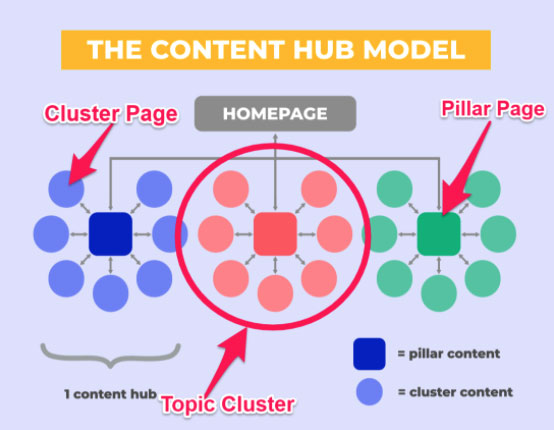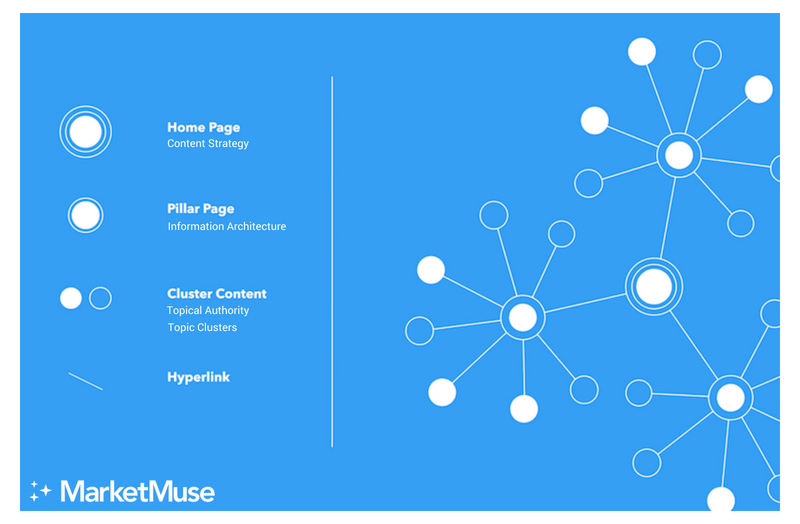Creating pillar content is an important SEO strategy. It helps to structure your content in a way that is helpful to users and to the algorithms that dictate where your site ranks in search results. But when it comes to WordPress, a frequently asked question is: “Are pages pillar content or posts on WordPress?”
In other words, when creating pillar content on WordPress, should you use pages or posts?
To answer that question, it helps to first have an understanding of what pillar content is, the purpose it serves and how it applies to a content management system like WordPress.
Here’s what you need to know.
What is pillar content?
Pillar content is part of an SEO strategy that involves structuring website content around a handful of core topics known as pillars. These pillars receive prime real estate in a website’s primary navigation. They should then link to additional supporting pieces of content known as topic clusters.

Think of pillar content like the foundation of your SEO content. This content is typically optimized for your most important short-tail keywords, upon which all your other content is built.
For example:
- Pillar page optimized for short-tail: “WordPress help” (pillar)
- Cluster content optimized for long-tail: “WordPress help for beginners,” “WordPress help for businesses,” “Who provides WordPress assistance?” (cluster topics)
What is the purpose of pillar content?
The main purpose of creating pillar content is to organize your website in a way that makes sense for users and search crawlers.
Typically, pillar content is linked directly from your home page or the primary navigation menus. This makes the content easiest to find when people come to your site. But also, by giving prime placement to those links, you are effectively telling search engines, “This is the most important content on my site. These keywords matter most.”

Then, by creating additional cluster content to support those pillars, you demonstrate your mastery of the subject. This helps users find the information they’re looking for more quickly. It also helps them pursue related topics more easily. For search engines, it shows that your site is well structured, easy to navigate and content-rich – all of which are important ranking factors.
What about pillar content on WordPress?
So, what’s the right way to create to pillar content on WordPress? What does it look like? How is it different from other types of pillar content?
The idea behind pillar content on WordPress is basically the same as pillar content on any other type of site. Your pillar pages serve as your most important content, optimized for your highest-value keywords. As such, those pages should be linked from the homepage of your WordPress site (or no more than 1 click from your homepage).
Now, this brings us back to the original question … Are pages pillar content or posts on WordPress? To answer this, it helps to first understand how to differentiate WordPress pages and posts.
WordPress Posts vs. Pages: What’s the Difference?
WordPress gives you two ways to add content to your website: posts and pages.
Conventionally, pages are intended to serve as the primary pages of your WordPress site, whereas posts are added to your blog. However, both types can be used to add virtually any type of SEO content to your site: informational, marketing, news, announcements and so on.

For example, posts can be designed to look like pages or can be customized in almost any way to separate them from your other blog content. And, if desired, pages can be timestamped to mimic the format of a blog. It really all depends on what your site goals are, because with WordPress there’s virtually no limit to your options.
So …
Are pages pillar content or posts on WordPress?
While there are no hard and fast rules, most SEO experts recommend using pages to create pillar content on WordPress. That’s because pillar pages are typically the most important pages on your site, so it makes structural sense to add those as pages, not posts.
That being said, your blog posts can serve as pillars too. And since WordPress gives you endless options for the design and format of these posts, including the URL structure, there’s no reason why your posts can’t be pillar content.
What’s most important is how you develop and structure your pillars and cluster content on your site.
Here are some tips on how to do it right.
7 Best Practices for Pillar Content on WordPress
1. Start with keyword research.
Most SEO experts will tell you not to think of your website strictly in terms of keywords. Instead, you should consider the broader topics that encompass the terms and subjects you want to rank for. However, keyword research is still an important part of this process.
To start, narrow down your most important keyword phrases to four or five pillar topics that match your SEO objectives. These terms should also be guided by search volumes and competition from other organic listings.
2. Create your pillar content as pages.
As we mentioned above, this isn’t a strict rule. But for the purposes of most WordPress sites, pages are a more natural fit for pillar content than posts.
3. Add high-quality content.
This is the important part. If you want your pillar pages to be successful, then the content needs to be good. The writing should be clear, authoritative and easy to read.
The design should be clean and easy to navigate. Break up long blocks of text with high-quality images, graphs, bullet points and so on.
Pillar pages should be exhaustive. Aim for at least 1,500 words to start and consider adding more content over time, as long as it’s relevant and genuinely useful to your audience. No fluff.
4. Link pillar pages from the homepage.
Remember: visibility is critical for pillars. Add links to the pages directly on the homepage and consider adding them to your primary navigation. This tells search engines that these pages are important.
5. Optimize and simplify URLs.
The URLs for your pillar pages should contain your keywords but otherwise should be as short as possible. Ideally, you should only include the keywords following your domain name.
For example:
- Good: https://wptangerine.com/wordpress-services/
- Bad: https://wptangerine.com/website/support-tools/wordpress-services/?p=63
This is especially important if you’re adding pillar content as posts on WordPress. Consider modifying the permalink to remove any unnecessary subdirectories that appear on your regular blog posts, such as /blog.
6. Create your topic cluster posts.
Each pillar should be supported by several cluster posts, which can be added as blog posts or pages. These topics should be guided by your keyword research, but again, the content needs to be useful, relevant and authoritative.
There is no limit to how many cluster posts you create. This is an ongoing SEO strategy in which you should be continually adding more content related to the original pillar topic.
7. Link it all together.
Each topic cluster should include a link back to its respective pillar page. Cluster pages should also link to other relevant cluster pages. Pillar pages can also link back to select cluster posts.
This linking process is what creates the clusters, so don’t skip this step!
Need some help?
If you need help restructuring your WordPress site, including URLs, layout, navigation or anything else, our WordPress experts at WP Tangerine are here for you. Get unlimited WordPress help and support for all your website to-dos, or use our Advanced WordPress SEO Services to get a customized SEO strategy and content development for your website.








